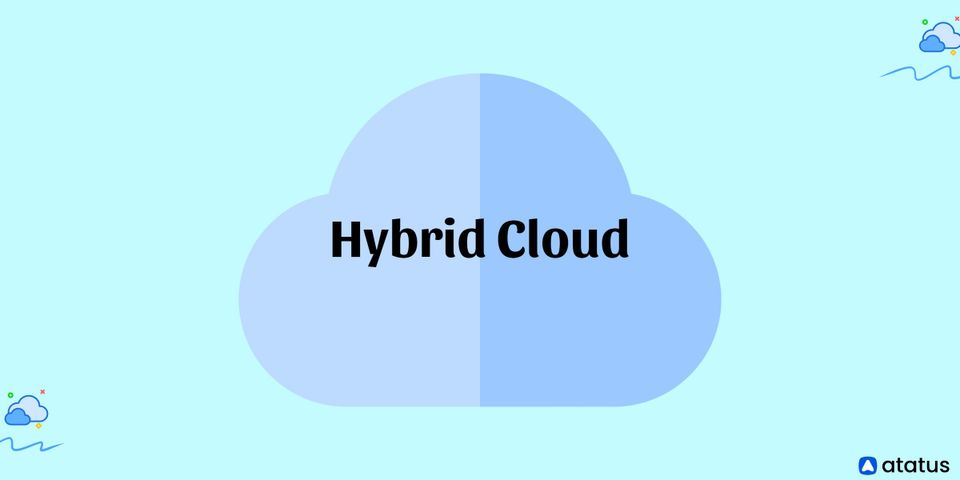Cloud computing has been a hot topic among IT decision-makers and corporate bean counters for several years, but many security-conscious companies have been reticent to shift data and workloads to the cloud. Now that the underlying technology behind cloud services is accessible for internal deployment, a new model known as Hybrid Cloud is gaining traction in the business world.
We will cover the following:
- What is Hybrid Cloud?
- Elements of Hybrid Cloud
- How Does Hybrid Cloud Work?
- Use Cases of Hybrid Cloud
- Benefits of Hybrid Cloud
- Challenges in Hybrid Cloud
What is Hybrid Cloud?
A hybrid cloud is a cloud computing environment that manages the usage of both on-premises private cloud and public cloud services from third parties. This requires the establishment of a connection between an on-premises data centre and a public cloud. Other private assets, such as edge devices or other clouds, may be involved in the connection.
As a result, a company may execute and scale traditional or cloud-native workloads on the most appropriate computing architecture in a single, unified, and flexible distributed computing environment.
In many circumstances, such as where high-performance computing is needed, hybrid cloud computing provides the ideal balance between the benefits of modern cloud technology and the practical constraints of cloud capabilities. It also enables businesses to take a staged approach to public cloud adoption based on outdated infrastructure, private data, and other factors.
Elements of Hybrid Cloud
The cloud and on-premises elements usually operate independently, and the goal of constructing a hybrid cloud is to create a seamless environment that harmonizes the two sides. The following elements must be considered in order to accomplish so:
- Unified Management
Different management tools are required for on-premises hardware and cloud networking. Data and resources are controlled in a single platform by unifying infrastructure under a hybrid approach. - Artificial Intelligence and Machine Learning
A hybrid cloud can fully maximize resources throughout the entire business due to automation enabled by artificial intelligence and machine learning. This reduces human error in repetitious operations while also allowing for proactive maintenance and policy enforcement. - Consistent Architecture
Every business will most certainly have some portion of their network in the cloud at some point in the future—this is where the technological curve is headed. In a hybrid environment, this means that traditional on-premises gear must coexist with cloud components. Organizations will be able to collaborate across both sides in a portable and flexible manner if they use a common architecture to govern. Symmetric deployments are also useful for cloud migration and disaster recovery planning.
How Does Hybrid Cloud Work?
With two types of clouds to consider, we'll need a vocabulary to define how applications and data are transferred between public and private clouds. This is what we refer to as a hybrid cloud architecture. A hybrid cloud, like an encrypted highway, allows operators to complete a single job using two different cloud resources.
Keep in mind, however, that most hybrid cloud architectures use two private clouds. The important thing to remember is that a hybrid combines the resources of two or more clouds. A hybrid cloud would be the total of both parts if you visualized a Venn diagram with an on-prem private cloud on the left and a cloud-hosted private cloud on the right.

The hybrid layer is represented by the overlapping space in the centre. This sliver of land between the clouds serves as a key link for data transmission. It enables businesses to make use of cloud capabilities without jeopardizing productivity or security.
Use Cases of Hybrid Cloud
In a variety of cases, a hybrid cloud is the best option. The following use cases demonstrate how hybrid cloud computing can be used most effectively.
- Development Lifecycle
Throughout the development process, resource requirements change. Certain resources will be required during the testing phase that will not be required during beta or even launch. These resources can scale according to the needs of each phase in a hybrid cloud environment. This provides flexibility throughout the life cycle without requiring hardware or configuration changes. - Disaster Recovery
Private and public disaster recovery can be fine-tuned with hybrid cloud solutions to match an organization's specific needs. This results in a more simple approach that conserves local storage space and bandwidth while streamlining the backup process. Assuring an efficient and speedy recovery of locally stored private data. This ensures continuity while also maximizing the efficiency that only a hybrid configuration can provide. - Workload Migration
A hybrid cloud solution can be a temporary setup that allows for permanent cloud migration. A business cloud migration could take months in some circumstances. Using a hybrid cloud to transition allows for a staged shift with simple and safe rollback, all while maintaining a level of flexibility that minimizes or even eliminates downtime. - Legacy Applications
Although many tools, applications, and resources can be migrated to the cloud, some still require on-premises resources. These scenarios are supported by hybrid cloud computing, which has the added benefit of allowing an organization to move to the cloud at its own pace.
Benefits of Hybrid Cloud
Hybrid cloud maintains a balance between on-premises and cloud networking, allowing businesses to construct their own hybrid cloud architecture to meet their individual requirements. The following are some of the major benefits of hybrid cloud:
- Flexibility
Users alter their infrastructure as they work with diverse sorts of data in varied situations. Without committing to a single vendor, a corporation can create a hybrid cloud that meets its needs by combining traditional systems with cutting-edge cloud technologies. When a hybrid cloud setup is used, organizations can shift workloads between their existing infrastructure and a vendor's public cloud as needed. - Cost Management
Organizations that use a private cloud own and run the data centre infrastructure, which comes at a high cost in terms of capital and fixed expenditures. The public cloud, on the other hand, provides resources and services that are accounted for as variable and operational costs. Hybrid cloud users can run workloads in the most cost-effective environment. - Agility and Scalability
In comparison to an organization's physical data centre, a hybrid cloud provides greater resource possibilities via a public cloud provider. This makes provisioning, deploying, and scaling resources to meet demand surges much easier. When local data centre capacity is reached, a business can burst the application to the public cloud to gain additional scale and capacity. - Resiliency and Interoperability
A business can operate workloads redundantly in both private and public environments to boost resiliency. Components of the same workload can execute in both contexts and communicate with one another. - Self-service
Through a self-service portal, IT users, such as developers and line-of-business managers, can have access to IT infrastructure and services in a well-designed hybrid cloud. This not only allows them rapid access to services but also relieves IT of the responsibility of acting as a middleman. - Compliance
Organizations in highly regulated industries are unable to migrate all workloads to the public cloud due to compliance limits on where data can be stored. Organizations can use a hybrid cloud to keep data private while running workloads in the cloud, or to run workloads in a private data centre and transport data to and from the public cloud as needed.
Challenges in Hybrid Cloud
Despite these advantages, there are certain issues to consider while using a hybrid cloud.
- Compatibility
In a hybrid cloud solution, on-premises and public cloud systems work together, although they are not totally compatible. It's hard to get both on-premises and public cloud systems to work together. - Data Handling
In a hybrid cloud, improper data location and mobility can lead to security and financial issues. Encrypt all traffic to keep data safe while in transit. Moving data across cloud environments, on the other hand, triggers cloud network and egress costs, which can quickly build up if it is not stored in the appropriate environment. - Complex Access Management
The issues of hybrid cloud security are exacerbated by authentication and permission. To access data in both private and public cloud settings, businesses must use centralized protocols. - Skills Gap
Hybrid cloud adoption requires a certain set of technical abilities from both users and IT employees. Working with a public cloud requires different skills than working with a private data centre, and the learning curve to bridge that gap might lead to human error. - Private Cloud Maintenance
The on-premises or private cloud component of a hybrid cloud requires significant investment, maintenance, and expertise. A private cloud's complexity may be increased by the addition of software such as databases, helpdesk systems, and other tools.
Conclusion
For businesses with a strong focus on security or unique physical presence requirements, a hybrid cloud can be a viable solution. It enables businesses to use public cloud services without transferring all of their data to a third-party data centre. This gives you a lot of flexibility in your computing tasks while keeping critical components safe behind the company's firewall.
Monitor Your Entire Application with Atatus
Atatus provides a set of performance measurement tools to monitor and improve the performance of your frontend, backends, logs and infrastructure applications in real-time. Our platform can capture millions of performance data points from your applications, allowing you to quickly resolve issues and ensure digital customer experiences.

Atatus can be beneficial to your business, which provides a comprehensive view of your application, including how it works, where performance bottlenecks exist, which users are most impacted, and which errors break your code for your frontend, backend, and infrastructure.



